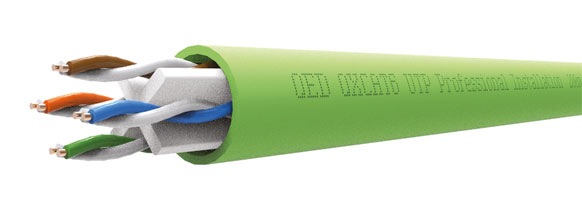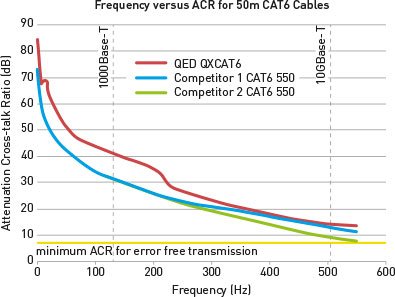ANALOGUE
With a vast array of technologies and our 40+ years in the specialist cable market, we produce cables to suit every budget to maximise the potential of your beloved system. With a vast array of technologies and our 40+ years in the specialist cable market, we produce cables to suit every budget to maximise the potential of your beloved system.
DIGITAL
Whether you’re connecting your TV to a sound bar or music server to a DAC, QED has a digital cable to meet your requirements. Our cables are tried and tested to ensure you get the best performance from your digital sources.
PHONO TO PHONO
When connecting your analogue sources such as your CD player or turntable to your amplifier, here at QED, we have a cable to suit your system. From our entry level Profile cable through to our flagship Signature Interconnect.
XLR
Using our unique Tri-Conductor technology and Neutrik XX-14 balanced plugs, our XLR cables offer the cleanest possible sound from a specialist XLR cable, whilst also incorporating our Ferrite insulation to eliminate timing errors.
DIGITAL COAXIAL
An alternative to optical, our premium digital coaxial cables use a specially designed cable cordage and unique plug design to achieve the precise signal characteristics required for high resolution and multi-channel audio.
USB A-B
With our high end USB A-B we isolate the power and data conductors preventing any potential cross talk, therefore meaning less jitter and an enhanced audio performance.
USB A-B MICRO
For use with Laptops/Computers and portable headphone amps/dacs, the QED reference USB A-Micro B uses our Ferrite insulation to reduce Jitter, as well as isolating the data and power lanes for a cleaner overall signal.
USB A-MINI B
Triple magnet screening and 24K gold plugs makes our Performance USB A-Mini B the best in its class.
JACK TO PHONO
Connecting your mobile device/tablet to your audio system has never been easier with our 2 step 3.5mm jack for a simpler connection.
HDMI
Using our in house HDMI testing facility, QED have designed premium HDMI cables to suit any budget. From our flexible and slimline profile to our exceptional Reference HDMI with its BandPass filter technology to reduce Jitter to Ultra low levels
OPTICAL
For all of your Optical needs, QED has an optical cable for you. For the more advanced, high bandwidth signals, Reference Optical Quartz uses glass technology to accurately send the information from source to receiver.
ETHERNET
The most common type of cable used for connecting products on a wired network. This cable connects wired devices together to the local network for file sharing and Internet access.
SUBWOOFER CABLE
Using technologies from our analogue cables such as complimentary conductor technology, your subwoofer will always perform to its best capability.
CAT6 Cables

When installing structured wiring for Ethernet you want to be certain that the physical layer can accommodate the currently required network standard plus any upgrades that might be needed in the future.
The most common standards encountered today in office or domestic environments are 10BaseT, 100BaseT and 1000BaseT which run at speeds of 10Mb/s, 100Mb/s and 1000Mb/s respectively. 1000BaseT is commonly referred to as Gigabit Ethernet and is the standard of choice for most modern installations. Gigabit Ethernet requires CAT5 cable or better. Consisting of four twisted copper pairs it must be capable of carrying the 125MHz base band frequency required to transmit 1Gb/s across the four data lanes over a maximum length of 100m; this is about the limit for CAT5e so in many installations CAT6 is used to ensure accurate transmission up to 100m.
10GBaseT and CAT6
In recent years an even faster standard called 10GBaseT has been introduced into more and more installations. This standard enables networks to carry up to 10Gb/s over standard four pair wiring using a base band frequency of 500MHz but in order to achieve this over 100m an enhanced and expensive cable structure is required in the form of CAT6a - however ordinary CAT6 cable can cope with the increased speed but only up to a maximum length of 55m.
Beware of exaggerated CAT6 claims
Increasingly cables are being marketed as "CAT6 550" or "CAT6e" - neither of which is an official cable designation. These are really just ordinary CAT6 cables and cannot be recommended for 10GBaseT installations because they will not work over more than 55m. QED Pro CAT6 cable is no different in this respect, but importantly we do not claim that our CAT6 cable is certified for 550MHz.

Why QED Pro CAT6 has superior performance
Although we do not make exaggerated claims for our CAT6 cable it is still superior to many that are dubbed CAT6 550 or CAT6e. In order to be certified for use in a network, cables must pass all the tests described in the international standards TIA-568-B & ISO 11801:2002. There are various parameters that have to be tested but the most pertinent of these is called ACR or "attenuation crosstalk ratio". This is a measure of how intelligible the signal remains at the receiving end of each twisted pair after being sent down the entire length of the cable. For the information to be entirely free of errors this measure must be at least 8dB. The graph shows how at every frequency a 50m QED Pro CAT6 cable outperforms two competitor cables that claim to be 550MHz certified even though we make no such exaggerated claims for our cable.
Conclusion
At the reduced length of 50m ordinary CAT6 cables can be used for 10GBaseT, however even with the superior performance of QED Pro CAT6 it is important that the installer ensures they do not exceed this advised maximum length during installation.